Dutch Researchers Explore Floating Solar Panels for Energy Transition

The Hague, Thursday, 1 August 2024.
TNO investigates floating solar systems on inland waters and seas to boost renewable energy in the Netherlands. With a projected 70 GWp capacity from water-based panels by 2050, research focuses on wind and wave effects, system longevity, and innovative designs like circular islands in IJsselmeer.
Harnessing Inland Waters and Seas
The Netherlands is leveraging its extensive network of inland waters and coastal areas to enhance its renewable energy capacity. By 2050, the country aims to generate 70 gigawatts-peak (GWp) of solar energy from water-based panels, with 25 GWp from inland waters and 45 GWp from offshore installations[1]. This ambitious plan seeks to address the growing demand for sustainable energy sources and reduce the reliance on fossil fuels.
Innovative Research and Testing
TNO’s research delves into the mechanical and electrical performance of floating solar systems, focusing on their durability in varied conditions, such as wind and wave impact. Key projects include the Fieldlab at Oostvoornse Meer, where solar systems are tested under challenging conditions, and the development of circular islands in IJsselmeer to create sheltered areas resistant to wave category 2 (waves up to 1 meter)[1]. These initiatives aim to create resilient and efficient floating solar solutions that can withstand harsh environmental factors.
Collaborative Efforts and Pilot Projects
Collaboration plays a critical role in TNO’s projects. Partners such as Oceans of Energy, SolarDuck, and Bluewater Energy Services are involved in various demonstration projects. For instance, the CrossWind HKN location hosts a project with Oceans of Energy, while the OTS location features the Merganser project with SolarDuck and Solar@Sea III with Bluewater Energy Services[1]. These pilot projects aim to gather systematic knowledge on performance and reliability, setting standards for future offshore solar energy systems.
Environmental and Economic Impact
According to a TNO report, the carbon footprint of floating solar systems is comparable to that of land-based systems, making them a viable complementary option[2]. Additionally, floating solar projects in Germany and the Netherlands have shown that these systems produce significantly lower CO2 emissions per kWh generated compared to traditional energy sources[3]. These findings underscore the potential of floating solar panels to contribute to the Netherlands’ energy transition while minimizing environmental impact.
Future Prospects and Challenges
As the Netherlands progresses towards its 2050 energy goals, continuous innovation and rigorous testing will be essential. Challenges such as system degradation and the need for maintenance must be addressed to ensure the long-term viability of floating solar systems. TNO’s ongoing research and pilot projects are crucial in overcoming these obstacles and paving the way for a sustainable energy future[1]. The success of these initiatives could serve as a model for other countries seeking to harness the potential of water-based renewable energy.

